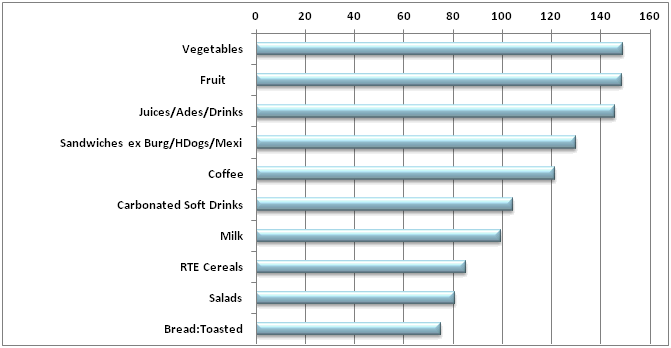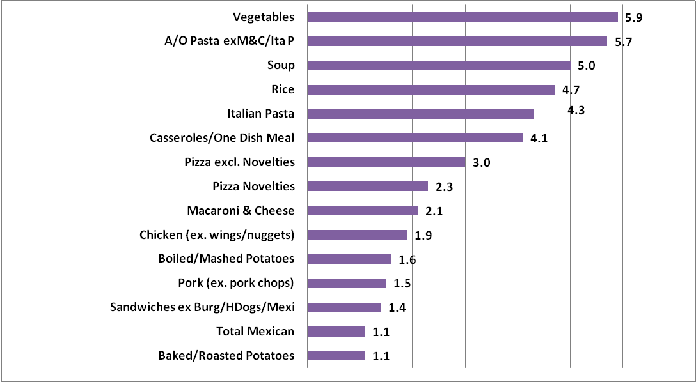| | Background | General consumption behavior of millennial, and implications and opportunities for the Agri-Food Sector| Some interesting facts about millennials’ food and beverage consumption | Millennials: their health and wellness | So what? | Source
,
Background
,
- Millennials, age 18-34 are almost as big an influence as Boomers age 45-64, as they now move through critical life stages :
- age 18-24 are more likely leaving high school and university to join the work force
- age 25-34 are likely to be forming relationships and families
- Millennials made up 23% of Canadian population versus 26% for Boomers
- ,Millennials are culturally more diverse than any other generation in Canada
- Millennials will not bring as sharp a spike in change as their parent’s generation. Their impact may be felt more in their highly connected cultural fusion
- As the next major influence on the Canadian landscape, Millennial will bring a very different perspective and agenda
General Consumption Behavior of Millennials and Implications and Opportunities for the Agri-Food Sector
Research Insights
Millennials report fewer meals and more meal skipping than Boomers.
While the majority of meals are prepared and eaten in home, Millennials show a higher percentage of meals carried from home than Boomers
- 58% of meals are prepared and eaten in-home
- 10% of meals are carried from home. This is especially true for breakfast and lunch.
When selecting meals Millennials in households without kids are more concerned about convenience, while Millennials in households with kids are greatly influenced by the need to please the entire family
- 32% of Millennials without kids are short cut fuelers
- 45% of Millennials with kids are family pleasers.
| Implications and Opportunities
The number of skipped meals for Millennials could be an opportunity to innovate and message around the value of eatings foods that provide fuel, are convenient to prepare, carry and eat on the run, as well as provide great nutrition
- Conduct primary research to understand why Millennials are skipping meals
- Evaluate opportunities to create foods and messaging about staying fuelled for day parts where skipping is more prominent; breakfast and lunch.
- Target Millennials with messaging about foods and beverages that can easily be carried from home, as 10% of their meals are prepared in-home, but eaten elsewhere
It is important to help Millennials learn to cook during this transition into more adult life stages. With almost 60% of meals being consumed in-home, the opportunity to provide recipes and cooking tips is great
- Focus on recipes that require less preparation time and fewer ingredients
- Convenience and taste are very important to Millennials, but Millennials in households with Kids also have interest in the nutritional value of the meal.
|
Some interesting Facts about Millennials’ Food and Beverage Consumption
Millennials, age 25-34 without kids are more likely to source meals away from home, or carry from home – and less likely to prepare and eat at home
- Millennials appear to choose simplicity in meals (measured as fewer number of Base Dishes) compared to Total Adults, and especially Adults 55+.
Annual meals per capita among Millennials – total venues

- Vegetables and fruit rank in the “Top 10 Foods and Beverages” across meal occasions for Millennials
Lunches prepared in the microwave by Millennials annual eating per capita – microwave)

- When using the microwave to prepare lunch, Vegetables, Pasta, Soup, and Rice are among the top foods for Millennials
- Millennials, age 18-24 are the least likely to eat leftovers, whereas age 25-34 without Kids are as likely as most adults to eat leftovers typically at dinner meals
Millennials: Their Health and Wellness
.
- The majority of Millennials (about 80%) report they are extremely or very healthy, but in truth 51% are overweight or obese
- Fewer Millennials are dieting than total adults (9% compared to 16%)
- Less than half of Millennials say, “I work hard to maintain a healthy lifestyle” (46% ) and while 43% report, “I seek out nutritious benefits”, only 21% say “I actively seek out information on nutrition and healthy eating”. This will vary by life stage for Millennials
- Only 14% of Millennials say “taste” is more important than “nutrition and only 9% say “convenience” is more important than “nutrition”, yet 25% of Millennials fall into a consumer segment where “convenience” dominates choices made for meals.
So What?
Implications of above research insights of Millennial’s health and wellness
- When messaging “health” and “nutrition”, “taste” and “convenience” cannot be forgotten.
- Address “meal skippers” with how important each meal of the day is for providing fuel, no matter what time of day or where that meal occurs.
- Position meals & snack foods for fuel and nutrition throughout the day, especially for carried-from-home meals and snacks.
- For this generation it may be beneficial to share health claims of foods in easy to find locations (social media, online, packaging), as well as provide information about healthy eating in media consumed by Millennials.
- Focus on the health benefits rather than just the health information as 46% say they look for benefits, but only 21% say they look for information.
- Also remember that the focus for health for these consumers may not be centered around medical conditions and dieting, but around energy and vitality. This generation is in an action-packed life stage.
Source
The NPD Group report on Canadian Baby Boomers 2010
The primary source of the Millennials Report is based on three different NPD Group services:
- National Eating Trends (NET) which tracks consumption behavior relating to retail and restaurants
- CREST Canada which collects information about purchase of prepared food and beverages at restaurants.
- Health Track Canada which adds attitudes and diet status to NET data base
- Snack Track, which tracks the consumption and sourcing of snack foods by individuals
Click Millennials to read article in pdf |
|